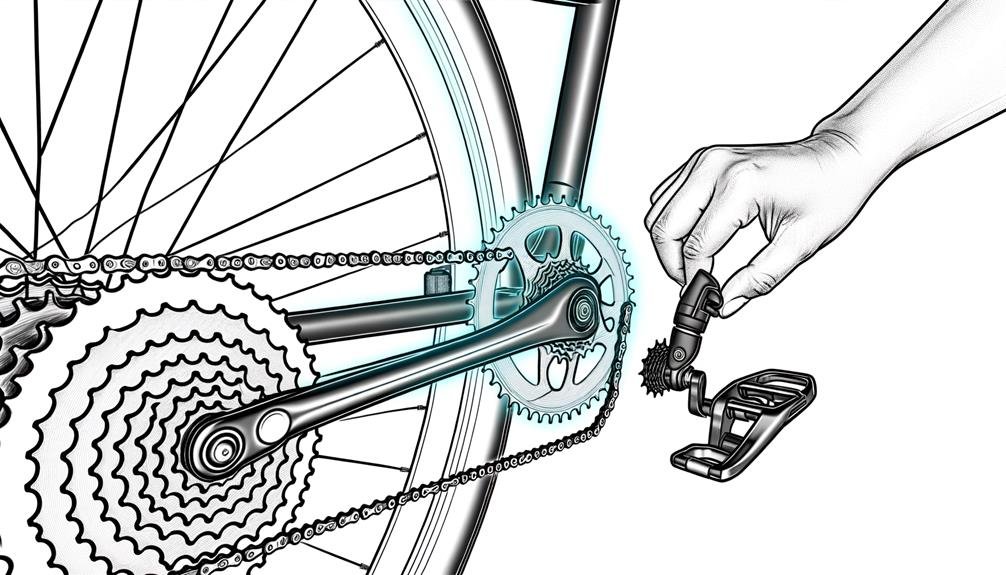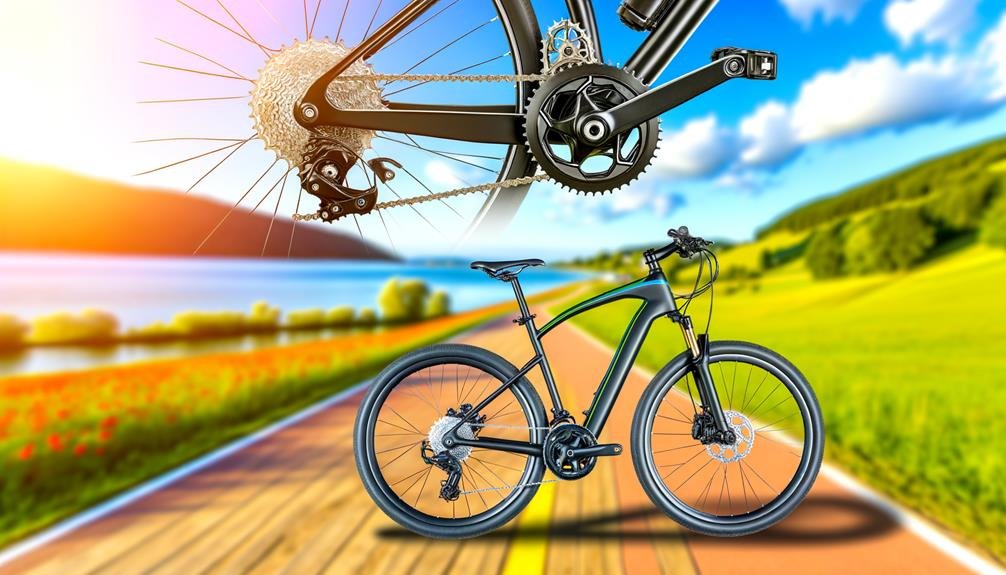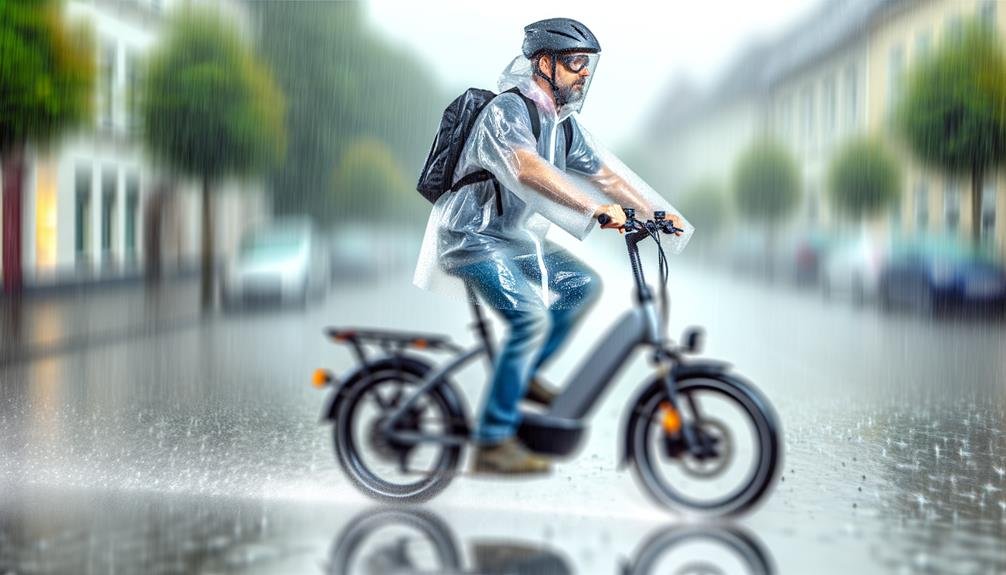Charles Miller is a veteran bike enthusiast with over 12 years of experience dealing with bikes as a mechanic. Despite immense love and expertise for...
In the world of transportation, electric bikes, or e-bikes, are the new kids on the block, acting like they're the high-tech cousins of our good old regular bikes. Well, the truth is they kind of are. As an avid cyclist and techie, I've often found myself in awe of how e-bike gears work.
These gears, trust me, are not mere cogs and chains, but a sophisticated blend of mechanical and electrical engineering. Have you ever wondered how these gears manage to give you that smooth ride up a steep hill, making you feel almost superhuman?
Well, let's embark on this journey together, and I promise, by the end, you'll be as fascinated as I am with the magic behind these gears.
- Key Takeaways
- Understanding Electric Bike Gears
- Types of Bike Gears
- Shifting Gears on Ebikes
- Tips for Effective Gear Shifting
- Decoding Different Ebike Speeds
- Role of the Derailleur on Ebikes
- Gear Selection for Various Terrains
- The Mechanics of Electronic Gear-Shifting
- Frequently Asked Questions
- Conclusion
Key Takeaways
- Electric bike gears determine the appropriate pedaling effort for different cycling needs such as climbing, cruising, and accelerating.
- Different types of gears serve specific purposes, such as hub gears for low-maintenance urban cycling, standard double gears for racing enthusiasts, and triple gears for efficient climbing in hilly areas.
- Understanding gear ratios is essential for finding the most energy-efficient rhythm and optimizing pedaling efficiency.
- Proper maintenance of the gear system, including cleaning and lubricating the chain, checking for wear or damage, and adjusting cables and derailleurs, ensures smooth gear shifting and optimal performance.
Understanding Electric Bike Gears
When it comes to electric bikes, understanding the different types of gears and their functions can significantly enhance your cycling experience. Electric bike gears are pivotal to an effortless ride, determining the right pedaling effort for climbing, cruising, and accelerating.
Each gear type, whether it's hub gears, standard double, triple, compact, or SRAM Apex, serves specific cycling needs. Shifters on electric bicycles vary, too, with different controls for front and rear gears. Mastering these can optimize your pedaling, making your ride smoother and more efficient. It's like being part of a special club, where understanding electric bike gears gives you an edge.
The secret to getting the most out of your electric bike gears is finding the most energy-efficient rhythm or cadence. Experimenting with different rhythms will help you discover what works best for you.
In essence, if you've ever wondered, 'how do electric bike gears work?' Then, the answer lies in their ability to determine speed, capability, and efficiency, influencing your overall riding experience. So, being part of the electric bicycle community isn't just about owning a bike; it's about understanding and mastering its components, especially the gears.
Types of Bike Gears
Now that we've gained a basic understanding of electric bike gears, let's explore the various types, including hub gears, standard double, triple, compact, and SRAM Apex. Each type has its unique features and benefits, catering to different styles and needs of biking.
Hub gears are housed in the rear hub and offer 4-14 gears. They're low-maintenance, making them popular among urban cyclists. The standard double, with two chainrings at the front and up to 11 sprocket variants at the rear, is the go-to for racing enthusiasts.
For those who frequent hilly areas, the triple, with its three chainrings and low gear, is perfect for efficient climbing. The compact, a smaller double gear setup, reduces gear ratios for challenging climbs or fast descents. Lastly, the SRAM Apex is a compact gear with a specially made rear derailleur, giving you a low-bottom gear and a larger top gear.
| Type of Gear | Mechanical Gears | Gear Ratios |
|---|---|---|
| Hub Gears | Housed in Rear Hub | 4-14 |
| Standard Double | Two Chainrings, Up to 11 Sprockets | Varies |
| Triple | Three Chainrings | Low for Climbing |
| Compact | Smaller Double Gear Setup | Reduced |
Understanding these types of bike gears is key to finding your perfect ride.
Shifting Gears on Ebikes

Now, let's talk about shifting gears on eBikes.
We'll first discuss the mechanics behind it.
Then, we'll move on to techniques for effective gear shifting.
Finally, we'll cover how to maintain your eBike's gear system.
Understanding these aspects can greatly improve your eBike experience, making rides smoother and more efficient.
Understanding Ebike Gear Mechanics
Grasping the mechanics of shifting gears on your eBike can greatly enhance your riding experience, catering to various terrain and speed requirements. Understanding ebike gear mechanics involves finding the right gear for climbing, cruising, and accelerating. This optimizes your pedaling efficiency and creates a smooth ride.
When shifting electric bike gears, it's essential to use the right shifter for your bike type. This controls both the front and rear gears, ensuring easier or more efficient pedaling. To effectively shift gears, anticipate the terrain and maintain suitable cadences. Avoiding abrupt gear changes can help maintain your bike's performance and drivetrain integrity.
Effective Gear Shifting Techniques
Mastering the art of effective gear shifting on your e-bike can turn challenging terrains into a smooth, enjoyable ride. This involves anticipating the terrain and moving the chain one gear at a time, especially on slopes.
Use easier gears to pedal at a higher cadence, not only for efficiency but also for knee safety. One key to effective gear shifting techniques is to avoid shifting too quickly. This prevents the chain from disengaging, ensuring you can handle your e-bike's gears properly.
Maintaining Ebike Gear System
To keep your e-bike running smoothly, it's essential to regularly maintain its gear system. Proper maintenance involves cleaning and lubricating the chain to ensure smooth gear shifting. Check your electric bike gears for signs of wear or damage, particularly on the gear teeth, chain, and rear derailleur components.
Adjusting the gear cables and derailleurs is equally important for precise and accurate shifting performance. Don't neglect the condition of your gear shifters either. If they're worn or unresponsive, it's time for a replacement.
If you're unsure about maintaining your ebike gear system, don't hesitate to seek professional help. A well-maintained gear system optimizes the performance of the electric motor, making your rides more enjoyable and efficient.
Tips for Effective Gear Shifting

Let's delve into five key tips for effective gear shifting on your electric bike. These tips are designed to enhance your overall biking experience, help you maintain a consistent speed, and prolong the lifespan of your bike's components.
- Anticipate Terrain Changes: One of the most useful tips for effective gear shifting involves anticipating terrain changes. When you're navigating slopes or hills, shift gears one at a time. This strategy allows for smoother transitions and reduces stress on your bike's drivetrain.
- Opt for Easier Gears: When pedaling, opt for easier gears. This helps maintain efficient pedaling and minimizes strain on your knees. It's all about creating a harmonious relationship between you and your bike!
- Avoid Rapid Gear Shifts: To prevent chain disengagement, avoid rapid gear shifts. Slow and steady wins the race when it comes to changing gears on your electric bike.
- Shift Before You Need To: Another important tip is to shift gears before you actually need to. This proactive approach ensures that you're always in the right gear for the upcoming terrain or road conditions. It also reduces the likelihood of sudden and jarring shifts.
- Practice and Experiment: Lastly, practice and experiment with different gear combinations. Every bike and rider are unique, so it's important to find the gear ratios that work best for you. Take the time to get familiar with your bike's gears and how they feel in different situations.
Decoding Different Ebike Speeds
Understanding the different speeds on eBikes often involves decoding the capabilities of various gears, from single-speed models designed for flat surfaces to nine-speed options that offer precise shifting and climbing abilities. As we delve into how do electric bike gears work, we will discover the versatility that different speeds bring to eBikes.
Here's a handy table to illustrate these gear types:
| Gear Type | Ideal For | Example Model |
|---|---|---|
| Single-speed | Flat surfaces, athletic riders | N/A |
| Seven-speed | Long distances, uneven terrains | The Ranger |
| Nine-speed | Precise shifting, climbing | QuietKat Apex |
| Electronic shifting | Convenience, customization | Shimano's Di2 |
This table shows that gears on an electric bike play a significant role in determining its speed and performance. So, when you're decoding different ebike speeds, consider the terrain you'll be traversing and your riding style. Single-speed bikes may suffice for city rides, but for adventurous trails, you might need a seven or nine-speed eBike. And for those desiring the ultimate convenience, electronic shifting mechanisms offer customizable gear-shifting settings. Remember, understanding your eBike's gears is the first step to a superior riding experience.
Role of the Derailleur on Ebikes

Now that we've examined how various gear types affect eBike speeds, let's shift our focus to the critical role the derailleur plays on these electric bikes. It's more than just a piece of hardware; it's the heart of the shifting system that allows you to finesse your ride to perfection.
The derailleur on an electric bike performs three key functions:
- It enables you to shift bike gears, helping you to adapt to fluctuating terrains and speeds.
- It guides the chain between different sprockets and chainrings, adjusting the gear ratio for optimal pedaling.
- It allows you to control these shifts via specific shifters located conveniently on the handlebars.
Understanding your derailleur and how it interacts with the rear wheel and chain can be a game changer for your eBike experience. Proper gear shifting involves paying attention to the terrain and adjusting gears to maintain an optimal cadence. This not only makes your ride smoother but also prolongs your eBike's lifespan.
Gear Selection for Various Terrains
Navigating different terrains on your eBike requires strategic gear selection, as each landscape presents its own unique challenges and demands. Understanding how electric bike gears work can make a significant difference in your ride's ease and efficiency. Whether you're on a mountain bike or just cruising around the city, the right gear selection for various terrains can enhance your eBike experience.
Here's a handy table to guide you through different kinds of terrains:
| Terrain | Gear | Reason |
|---|---|---|
| Uphill | Low gear | Efficient climbing |
| Flat or rolling | Middle gear | Everyday cruising |
| Downhill or flat roads | High gear | Acceleration and descending |
| Experimentation | Varies | Find most energy-efficient gear |
| Optimum cadence | Varies | 60-80 rpm for climbing, 80-90 rpm for flat terrains |
The Mechanics of Electronic Gear-Shifting

Let's get into the nuts and bolts of electronic gear-shifting on electric bikes.
We'll first grasp how this high-tech system works.
Then, we'll explore the advantages it brings to your ride.
Lastly, we'll tackle common issues that might come up and how to troubleshoot them.
Understanding Electronic Gear-Shifting
Diving into the mechanics of electronic gear-shifting, systems like Shimano's Di2 employ electronic switches to maneuver gears, sending signals to a battery-powered derailleur motor for precise, low-maintenance gear changes. This is how electric bike gears work.
When shifting gears, I use the left shifter to adjust the electric assistance level. This helps control how much help I get from the motor.
The right shifter changes the mechanical gears, making the ride more comfortable and less exhausting.
The perks of understanding electronic gear-shifting include less maintenance and customizable settings.
Benefits of Electric Gears
With electronic gear-shifting, I'm finding that maintenance is less of a hassle, and the ability to customize settings offers a unique advantage. The benefits of electric gears are clear: they simplify the complexities of traditional cycling. When you ask, 'how do electric bike gears work?', it's a digital revolution. They're easily adjustable and offer us the freedom to switch modes, enhancing the pedal assist feature on our rides.
The convenience and versatility of electric bike gears make us feel part of a community that values ease and efficiency. No longer are we burdened by mechanical complications. Instead, we're part of a cycling evolution, reaping the rewards of technological innovation.
Troubleshooting Electric Gear Issues
While the benefits of electric gears outweigh the challenges, it's worth knowing how to troubleshoot common issues to keep your ride smooth and efficient. When troubleshooting electric gear issues, there are a few key steps:
- Firstly, always check your battery. It must be fully charged and properly connected. This is crucial for electric mountain bikes where the rear hub powers the gears.
- Secondly, inspect all cables and connections. Look for any loose or damaged parts that could be affecting gear shifting.
- Lastly, don't hesitate to reset the system to its default settings.
Understanding how do electric bike gears work may seem daunting at first, but with a little practice, you'll soon feel like part of the e-bike community.
Frequently Asked Questions
What Gear Do You Use When Going Uphill on an Ebike?
When I'm tackling uphill terrains on my ebike, I always opt for a low gear. It's the small chainring at the front and the largest sprocket at the rear that make my ride easier.
How Does an Electric Bike Shifter Work?
As an e-bike rider, I use the shifter to change gears. I press the up button to shift higher, and the down button for lower gears. It's as simple as that, you'll get the hang of it!
Do You Have to Change Gears on an Electric Bike?
Yes, you do need to shift gears on an electric bike. It's like driving a car; you adjust the gears based on your speed and the terrain. Proper shifting helps maintain optimal pedal efficiency and bike performance.
How Many Gears Does an Electric Bike Have?
Just like a symphony has various notes, an electric bike can have from 1 to 9 or more gears. It's all about the ride's purpose and terrain. More gears offer better control and efficient pedaling.
Conclusion
So, shifting swiftly and smoothly on an e-bike can significantly simplify your cycling journey.
The secret lies in selecting suitable gears for diverse terrains, deciphering the difference in speeds, and mastering the mechanics of electronic gear-shifting.
Done right, it's not just about getting from A to B, but relishing the ride in between.
Remember, practice makes perfect, so don't be deterred by initial difficulties.
Delve into the dynamics of e-bike gears and discover a new dimension of cycling comfort.

Charles Miller is a veteran bike enthusiast with over 12 years of experience dealing with bikes as a mechanic. Despite immense love and expertise for his Tacoma, he rides his Trek Ebike more. Anytime you meet him, you’ll either hear him talking about Bikes, or writing about all things bikes and cars on this blog.
More Posts


